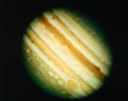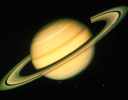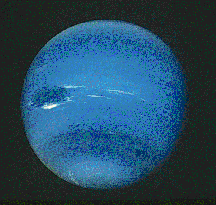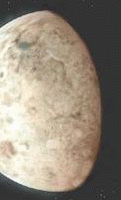Multiply your weight times the surface gravity on other planets .... |
Planets |
Jupiter-It is the largest planet in our Solar System and orbits the Sun at a distance of 778 million km. Compared to the size of Earth, Jupiter is 1,000 times bigger. Jupiter is said to have 16 moons but there may be more. Jupiter is the brightest object in the sky after the Sun, Moon, and Venus. |
Mercury- Mercury is the closest planet to the Sun in our solar system. It orbits nearly 58 million km. away from the sun. Mercury is so close to the sun that the daytime temperatures are over four times as hot as boiling water, thats 800 deegrees farenheit. |
Venus- Venus is about the same size as the Earth. Although the Earth rotates to the right and Venus rortates to the left. It orbits the Sun at a distance of about 109 km. Its mostly flat surface areas resemble the Earth's 7 continents. |
Earth- The Earth is about 150 million km. away from the Sun. This distance from the Sun causes the planet to have the right temperature for water to exist as a liquid, apposed to existing as ice or vapor. The planet Earth takes exactly 365.256 days to orbit the sun and has a breathable atmosphere. |
Mars- It is the fourth planet in our solar system and orbits the Sun at about 227 million km. away. At almost a doubled Earth year, Mars takes nearly 687 days to orbit the Sun. It is possible to see Mars with the naked eye yet it only looks like a bright red-orange star. You would need a powerful telescope to see any details. |
Saturn-The second largest planet in our Solar System, Saturn orbits the Sun at about 1,429 million km. It takes 29 earth years for Saturn to orbit the Sun. Saturn is often called the ringed planet because of the distinctive rings of dust and rocks surrounding it. |
Uranus-The seventh planet from the Sun, Uranus is about 2,875 million km. away. It takes little over 84 earth years for the planet to orbit the Sun. In 1781 Uranus was identified as a planet by a British astromomer named William Herschel. |
Neptune-The fourth of our gas giants, Neptune is slightly smaller than Uranus and rotates once every 16 hours. In 1846 it was identified as a planet by a German astronomer by the name of Johann Gottfried Galle. |
Pluto-Our most distant planet from the Sun, Pluto has an oval shaped orbit. This takes it closer to the Sun than Neptune for 20 years of its 249 year orbit. The last time neptune was farthest away from the Sun was from 1979 to 1999. |
Mercury 57.9 36 |
Venus 108.2 67.2 |
Earth 149.6 93 |
Mars 227.9 141.6 |
Jupiter 778.3 483.6 |
Saturn 1,429 888.2 |
Uranus 2,875 1,786 |
Neptune 4,504 2,799 |
Pluto 5,900 3,666 |
Distance from the Sun ... Millions of Kilometers |
Distance from the Sun ... Millions of Miles |
Multiply your weight times the surface gravity on other planets .... |








